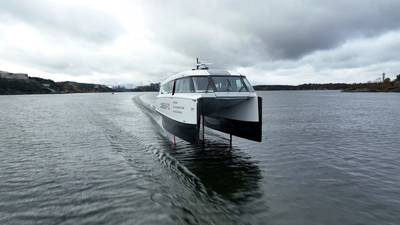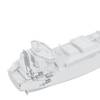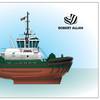Flying Electric Ferry Coming to Lake Tahoe
Skiers in Tahoe will soon reach the slopes faster, as Candela and FlyTahoe announce the introduction of the first U.S.-based Candela P-12, a groundbreaking foiling electric ferry, on Lake Tahoe.
• The world's first electric, hydrofoiling ferry will reduce travel times for Tahoe locals and visitors, providing a much-needed north-south connection across the lake, while also helping to cut emissions.
• The Candela P-12 is the fastest electric vessel in the world with the longest range and significantly lower operational costs than diesel-powered vessels.
• This marks the introduction of electric hydrofoiling passenger ships in the U.S., a crucial step towards decarbonizing maritime transport on American waterways.
With Lake Tahoe attracting over 15 million outdoor enthusiasts year-round, road congestion has become an ever-increasing problem. Travellers often find themselves stuck in long car lines, especially in winter, due to road closures caused by heavy snowfalls.
However, local company FlyTahoe and the tech company Candela are set to solve this by introducing a revolutionary zero-emission vessel that will make its U.S. debut: the world’s first flying electric ferry, the Candela P-12, which recently launched on Stockholm’s waterways. FlyTahoe will feature a 30-minute cross-lake service, cutting the travel time in half compared to the daily 20,000 car trips along the same route.
The Candela P-12 was recently launched into service by Stockholm's public transport company, becoming the first operator of this innovative vessel.
The P-12 is the world’s first electric hydrofoil ferry, hailed as a “game changer” for waterborne transport by combining long range with high speed and a revolution in energy efficiency. This 30-seat vessel, designed to accommodate both skis and bikes, uses hydrofoil technology—computer-guided underwater wings—to fly above the water’s surface at high speeds, unaffected by waves and winds.
The wings lift the hull above the water, significantly reducing drag and cutting energy consumption by a staggering 80% compared to conventional vessels. This is what allows the P-12 to be fully propelled by renewable electricity instead of fossil fuels, while providing a smooth ride above the waves even at high speeds.
Passengers prone to seasickness need not worry. The high-tech vessel’s computer Flight Controller uses sensors and software to balance the craft above the waves and amidst the winds, adjusting the foil’s angle of attack 100 times per second to provide a silent and smooth ride.
"It basically works like a jet fighter, which is constantly balanced using ailerons. The principle of the P-12 is the same, except our wings fly in water instead of air," says Gustav Hasselskog, CEO and Founder of Swedish tech company Candela.
The P-12’s cruising speed of 25 knots (~30 mph) —the fastest for any electric vessel—is crucial for commuters looking to cut travel times. The FlyTahoe ferry will connect the northern and southern parts of the lake in under 30 minutes, while driving around the lake often takes over two hours in the winter. FlyTahoe will create a vital link to the 14 world-class ski resorts encircling the lake, making it an ideal option for tourists and locals alike.
“It's ironic that while millions, myself included, drive around Lake Tahoe to admire its beauty, the road sediment we generate contributes to the largest threat to the lake's famous cobalt blue clarity. Our service will provide a faster transport than cars or buses, while keeping Tahoe blue," says Ryan Meinzer, Founder & CEO of FlyTahoe.
Since Lake Tahoe, the second deepest lake in the US, never freezes over, the ferry can operate year-round. This added mobility convenience will enhance business and improve the lives of both locals and tourists, providing a versatile zero-emission solution to reduce traffic during both summer and winter seasons.
A detailed analysis by the Tahoe Transportation District already recognized ferries as the best solution to reduce traffic congestion along Lake Tahoe’s north-south route, citing lower costs per user and faster travel times than cars and buses. However, that analysis, conducted before the advent of the P-12 technology, did not account for the electric ferry's ability to reduce energy usage by 80% compared to traditional ferries—a factor that Meinzer says significantly bolsters the unit economics and overall business case.
"This fusion of flight and electric technologies not only unveils a powerful new business opportunity with nearly 10x operational efficiency but also offers an unmatched customer experience of comfort and safety. Plus, we'll not just be moving people faster; we'll be boosting socio-economic mobility by connecting the north and south of the lake,” Meinzer adds.
"We’re proud to partner with FlyTahoe to bring this revolutionary technology to the U.S. for the very first time. This will not only ensure more efficient commuting around Lake Tahoe and unlock business possibilities for waterfront communities, but it’s also a big step toward unlocking the potential of U.S. waterways for zero-emission transport," says Gustav Hasselskog, of Candela.
P12 at a glance ...
- Candela P-12 Specifications
- Length: 11.99 meters/39.24 feet
- Beam: 4.5 meters/14.76 feet
- Weight: 10 tonnes
- Capacity: 30 passengers (seated) + 1 crew
- Propulsion: 2 x Candela C-POD, 320 kW peak power in total
- Charging: Up to 200 kW DC
- Service Speed: 25 knots
- Range: 40 nautical miles at 25 knots service speed
Photo Caption: The first and second manufactured Candela P-12's flying across Stockholm's waters at 25 knots.














